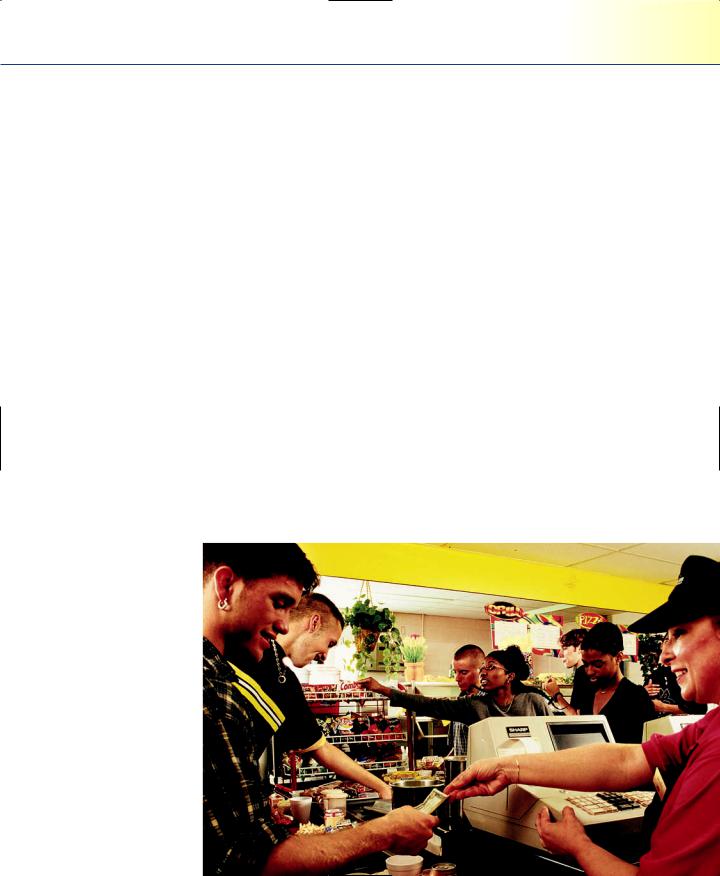
- •CONTENTS
- •PREFACE
- •Content—Benefits for Students
- •Content—Benefits for Instructors
- •Features of the Book for Students and Instructors
- •Supplementary Materials
- •Acknowledgments
- •What Is Hospitality Management?
- •The Manager’s Role in the Hospitality Industry
- •Why Study in a Hospitality Management Program?
- •Planning a Career
- •Employment as an Important Part of Your Education
- •Getting a Job
- •Employment at Graduation
- •The Outlook for Hospitality
- •Summary
- •Managing Change
- •Demand
- •Supply
- •Workforce Diversity
- •The Impact of Labor Scarcity
- •Summary
- •The Varied Field of Food Service
- •The Restaurant Business
- •The Dining Market and the Eating Market
- •Contemporary Popular-Priced Restaurants
- •Restaurants as Part of a Larger Business
- •Summary
- •Restaurant Operations
- •Making a Profit in Food Service Operations
- •Life in the Restaurant Business
- •Summary
- •Chain Restaurant Systems
- •Independent Restaurants
- •Franchised Restaurants
- •Summary
- •Competitive Conditions in Food Service
- •The Marketing Mix
- •Competition with Other Industries
- •Summary
- •Self-Operated Facilities
- •Managed-Services Companies
- •Business and Industry Food Service
- •College and University Food Service
- •Health Care Food Service
- •School and Community Food Service
- •Other Segments
- •Vending
- •Summary
- •Consumer Concerns
- •Food Service and the Environment
- •Technology
- •Summary
- •The Evolution of Lodging
- •Classifications of Hotel Properties
- •Types of Travelers
- •Anticipating Guest Needs in Providing Hospitality Service
- •Service, Service, Service
- •Summary
- •Major Functional Departments
- •The Rooms Side of the House
- •Hotel Food and Beverage Operations
- •Staff and Support Departments
- •Income and Expense Patterns and Control
- •Entry Ports and Careers
- •Summary
- •The Economics of the Hotel Business
- •Dimensions of the Hotel Investment Decision
- •Summary
- •The Conditions of Competition
- •The Marketing Mix in Lodging
- •Product in a Segmented Market
- •Price and Pricing Tactics
- •Place—and Places
- •Promotion: Marketing Communication
- •Summary
- •The Importance of Tourism
- •Travel Trends
- •The Economic Significance of Tourism
- •The United States as an International Tourist Attraction
- •Businesses Serving the Traveler
- •Noneconomic Effects of Tourism
- •Summary
- •Motives and Destinations
- •Mass-Market Tourism
- •Planned Play Environments
- •Casinos and Gaming
- •Urban Entertainment Centers
- •Temporary Attractions: Fairs and Festivals
- •Natural Environments
- •On a Lighter Note. . .
- •Summary
- •Management and Supervision
- •The Economizing Society
- •The Managerial Revolution
- •Management: A Dynamic Force in a Changing Industry
- •What Is Management?
- •Summary
- •Why Study Planning?
- •Planning in Organizations
- •Goal Setting
- •Planning in Operations
- •The Individual Worker as Planner
- •Long-Range Planning Tools
- •Summary
- •Authority: The Cement of Organizations
- •Departmentalization
- •Line and Staff
- •Issues in Organizing
- •Summary
- •Issues in Human-Resources Management
- •Fitting People to Jobs
- •Recruiting
- •Selection and Employment
- •Training
- •Retaining Employees
- •Staff Planning
- •Summary
- •The Importance of Control
- •Control and the “Cybernetic Loop”
- •Tools for Control
- •Summary
- •Leadership as Viewed by Social Scientists
- •Why People Follow
- •Leadership Theories
- •Communication
- •The Elements of Leading and Directing
- •Developing Your Own Leadership Style
- •Summary
- •A Study of Service
- •Rendering Personal Service
- •Managing the Service Transaction
- •How Companies Organize for Service
- •Summary
- •INDEX

648 |
Chapter 21 The Role of Service in the Hospitality Industry |
A Study of Service
“Dear Mr. Wilson,” the letter from Mortimer Andrews to the company president began, “Yesterday I arrived at your hotel in Chicago with a confirmed reservation guaranteed by my credit card only to be told that no room was available. I was
furious and let the desk clerk know how I felt in no uncertain terms. The clerk, John Boyles, handled the situation so well that I wanted to write and tell you about it.
“John responded to my very angry tirade about my reservation by admitting the mistake was the hotel’s. He said that he had made reservations for me at a nearby Sheraton and that your hotel would take care of the difference in the room rate. When I reluctantly agreed, he called a cab—-after letting me know your hotel would pay the cab fare, too.
“What struck me was John’s real concern for my situation, his professional manner, and the fact that he didn’t give me any excuses: ‘It was our mistake and we’re anxious to do everything we can to make it right.’ John carried my bags out and put me in the cab, convincing me that somebody really cared about this weary traveler.
“I travel a lot and it’s hard work without the extra hassles and foul-ups. On the other hand, everybody makes mistakes. John’s concern and assistance make a big difference in the way it feels when one of them happens to you. I thought you should know about this young man’s superior performance. He is a real asset to your company. He restored my faith in your hotel, and I’ll be back.”
This incident may not seem like a major event, but consider for a moment just what the stakes are. Mr. Andrews is a frequent traveler. If we assume that he is on the road an average of two days a week, at the end of the year his business would be the equivalent of a meeting for 100 people. If we assume an average rate (in all cities he visits, large and small) of $75 per night, the room revenue involved is $7,500. Using industry averages, he is likely to spend an additional $3,250 on food and beverage. In other words, the receipts from this one guest amount to a $10,000 piece of business— and there is no shortage of other hotels he could stay at if he doesn’t like yours. Extend this over several years and one begins to understand the long-term importance of keeping guests happy (in fact, some hospitality companies conduct this very exercise to determine the long-term value that a customer has to a company).
The rule of thumb, moreover, is that a dissatisfied customer will tell the story of his or her problem to ten others. The possibility for bad word of mouth and potential loss of other sales makes the problem of the dissatisfied guest even more serious.
In fact, a study of 2,600 business units in all kinds of industries, conducted by the Strategic Planning Institute, has been summarized in this way: “In all industries, when competitors are roughly matched, those that stress customer service will win.”1 If this

A Study of Service |
649 |
is true in manufacturing and distribution, how much truer it must be for those of us whose business is service.
The population group that has dominated the hospitality industry (and most of the rest of the economy) is the baby boomers. Over the next ten years, this group will continue to move into the relatively well-off middle years. They are the best-educated consumers in history. These relatively affluent, sophisticated consumers (as we have noted elsewhere in this text) can afford and will pay for good service. Moreover, competitive options give them plenty of other places to go if they don’t receive the kind of service they seek. It is not too much to say that excellence in service will be a matter of survival into the foreseeable future.
The role that John Boyles played in keeping Mr. Andrews’ business illustrates how important the service employee is in hospitality. That incident invites us to consider just what service is, how it is rendered in hospitality companies, and how companies can organize for and manage service. These are the subjects of this chapter.
WHAT IS SERVICE?
“Service,” according to one authority, “is all actions and reactions that customers perceive they have purchased.”2 In hospitality, service is performed for the guest by people or (less frequently) by systems such as the remote guest check-out operated through a hotel’s television screen. The emphasis in our definition is on the guest’s total experience, which is made up of all of these so-called moments of truth. Indeed,
From the guest’s point of view, service is the performance of the organization and its staff. (Courtesy of Sodexho.)

650Chapter 21 The Role of Service in the Hospitality Industry
from the guest’s point of view, service is the performance of the organization and its staff.
In most segments of the hospitality industry, the guest and the employee are both personally involved in the service transaction. If a customer purchases a pair of shoes or a car, he or she takes the finished product away without much, if any, concern about who made it or how. On the other hand, in hospitality, to give one example, a lunch is served. The service is produced and consumed at the same time. The service experience is an essential element in the transaction. If the server is grumpy and heavyhanded, it is likely that the guest will be unhappy. A cheerful and efficient server enhances the guest experience.
Notice we say “enhances.” The tangible side of the transaction (the “product”) must be acceptable, too. All the cheerfulness in the world will not make up for a bad meal or a dirty guest room. At the same time, it is also true that a good meal can be ruined by a surly server, just as a chaotic front office or poor service from the bell staff can ruin a stay in a hotel that is physically in excellent shape. The hospitality product, then, includes both tangible goods (meals, rooms) and less tangible services. Both are essential to success.
The server’s behavior is, in effect, a part of the product (and of the total guest experience). Because servers are not the same every day—-or for every guest—-there is a necessary variability in this “product” that would not be encountered in a manufactured product. The guest is also a part of the service transaction. A guest who is not feeling well or who takes a dislike to a member of the staff may have a bad experience in spite of all efforts to please.
Because service “happens” to somebody, there can be no recall of a “defective product.” It is now a guest’s experience (and, in a sense, history). For this reason, there is general agreement that the only acceptable performance standard for a service organization is zero defects. Defects, however, should be defined in terms of the type of operation and the guest’s expectations. At a McDonald’s, waiting lines can be expected during the rush hour and will be accepted as long as they move with reasonable speed. However, a dirty or cluttered McDonald’s, even in a rush period, represents a “defect,” an emergency that needs to be remedied right away. On the other hand, a waiting line at a restaurant in a Four Seasons Hotel is, by Four Seasons’ own definition, a defect. It is an emergency that needs to be remedied by a hostess or manager offering coffee or soft drinks and apologizing for the delay. Zero defects is the goal for which both organizations design their systems, but what counts as a defect varies according to company goals and customer expectations. This is the reason that hospitality companies establish standards—-to help create consistency and to eliminate the margin for error. While neither McDonald’s or Four Seasons is perfect, both have standards and dictate emergency action, such as management stepping in to help out, when a defect occurs. The notion of zero defects has also been approached in a more

INDUSTRY PRACTICE NOTE 21.1
Six Sigma Comes to the Hospitality Industry1
The concept known as Six Sigma has been around for almost 20 years now and originated, as many theories and techniques do, in the manufacturing segment. It was first used by Motorola and later embraced by General Electric, among others. It has only recently been introduced to the hospitality industry, though, when Starwood Hotels adopted it into their hotels in 2001.
Six Sigma is a statistically based business strategy that companies attempt to apply to help in reducing (and virtually eliminating) defects in products and services. In the case of the hospitality industry, in theory, it could be used to improve services from hotel check-in to waiting times for tables in restaurants. The name comes from the term sigma, which is the Latin word used for the standard deviation. In essence, it shrinks the acceptable range of performance. Six is the number from the mean (average) that is nearer to zero defects. In short, the technique attempts to quantify acceptable limits as they relate to customer satisfaction. In theory, the rate of errors (or defects) is reduced to less than one-thousandth of a percent. It is estimated that many firms operate within the three-sigma range.
While the technique/program has been in use relatively widely in manufacturing firms (approximately 15 percent of Fortune 1000 companies use it in one form or another), Starwood was the first hospitality company to introduce it. They have implemented a fully developed program that starts at the corporate level and identifies key people at the unit level to champion it.
The six steps of achieving Six Sigma are as follows:
Creating and identifying strategic business objectives
Creating core and subprocesses
Identifying process owners
Creating and validating performance measures
Collecting data on performance measures
Determining and prioritizing projects for improvement2
The prime objectives are to improve systems and delivery, increase customer satisfaction, and reduce costs. One scholar suggests that, in the hospitality industry, it may be more readily applicable to back-of- the-house functions than to the front of the house. Nonetheless, it is another example of how hospitality operators are attempting to improve their service and service quality.
1.Much of this note was based upon a paper presented by Harsha Chacko at the 2003 Council on Hotel, Restaurant and Institutional Education conference, “Six Sigma: Here to Stay or Just Another Fad?”
2.George Eckes, The Six Sigma Revolution (New York: John Wiley & Sons, 2001).
statistical manner focusing on the business method known as Six Sigma—-the subject of Industry Practice Note 21.1.
Because the consumption of the service and its production occur simultaneously, there is no inventory. An unused room, as the old saw goes, can never be sold again.
651

652Chapter 21 The Role of Service in the Hospitality Industry
A dining room provides not only meals but the capacity of a certain number of seats. While unused food remains in inventory at the end of the day, unused capacity—-an unused table today—-has no use tomorrow. This puts pressure on hospitality businesses to operate at as high a level of capacity as possible, offering special rates to quantity purchasers. A hotel’s corporate rate structure is one example of such quantity pricing.
Let us summarize the characteristics of service that we have identified to this point. Service is experience for the guest, performance for the server. In either case, it is intangible, and the guest and server are both a part of the transaction. This personal element makes service quality control difficult—-and quite different from manufactured products. Because there is no possibility of undoing the guest’s experience, the standard for service operations must be zero defects. Finally, production and consumption are simultaneous. Thus, there is no inventory.
Face-to-face service transactions have the most power to make an impression on the guest. (Courtesy of Sodexho.)
TYPES OF SERVICE
There are three general types of service transactions: electronic-mechanical, indirect personal, and face-to- face transactions.3
Electronic-mechanical transactions in hospitality range from vending machines to such services as automated check-in and check-out. Other examples are the well-stocked in-room refrigerator that takes over much of the room service department’s work in a hotel and a hotel’s automatic-dial telephone system. Elec- tronic-mechanical transactions are generally acceptable and sometimes even preferred by the guest where they eliminate inconvenience, such as waiting in lines. On the other hand, as frequently vandalized vending machines eloquently testify, electronic and mechanical failures often infuriate people. There is a premium on correct stocking, maintenance, proper programming, and adequate capacity so that breakdowns in service will not occur when no person is there to speak personally for the operation.
Indirect personal transactions include telephone (or e-mail) contacts such as hotel reservation services, the reservation desk at a restaurant, or the

A Study of Service |
653 |
work of a room service order-taker. Some indirect transactions such as those just mentioned are generally repetitious in nature and, thus, subject to careful scripting. That is, because most of these interactions follow a few, very similar patterns, the employee can be trained in considerable detail as to what to say and when to say it. Some indirect contacts, however, are nonstandard. For instance, a guest calls the maintenance or housekeeping department directly from his or her room with a problem. An individual response to the particular guest problem is necessary, but the general procedure in such cases can be clearly specified in advance. Training in telephone manners—-and careful attention to just who answers the phone in departments that don’t specialize in guest contact work—-is essential to maintaining the guest’s perception of the property.
Face-to-face transactions have the most power to make an impression on the guest. Here, the guest can take a fuller measure of people—-their appearance and manner. People whose work involves frequent personal contact with guests must be both selected and trained to be conscious, effective representatives of the organization. Because an increasing part of the services in modern organizations are automated, the personal contact that does take place must be of a superior quality. It is also important that public-contact employees be prepared to deal sympathetically with complaints about automated services. As John Naisbitt (a futurist and author of Megatrends) has pointed out, the more people have to cope with high technology, the more they require a sympathetic human response from the people
in organizations. Naisbitt calls it “high |
|
|||
touch.”4 |
|
|
|
|
We must continue to be interested |
|
|||
in all kinds of service |
transactions, |
■ An experience that happens to the |
||
whether personal or not. The work of |
||||
guest. No recall of defects is pre- |
||||
designing |
computerized |
systems or |
||
ferred. |
||||
scripting |
standardized indirect trans- |
■ Performance for the organization. |
||
actions, however, is generally special- |
Zero defects is the service systems |
|||
design goal. |
||||
ized and |
done by experts. Virtually |
|||
■ A process whose production and |
||||
all of us, on the other hand, will have |
||||
consumption are simultaneous. |
||||
to deal with guests face-to-face. |
||||
Unsold “inventory” has no value. |
||||
Accordingly, much of our attention |
■ Because the employee is so much a |
|||
in the balance of this chapter will fo- |
part of the guest’s experience, the |
|||
employee is part of the product. |
||||
cus on personal service. Figure 21.1 |
||||
|
||||
summarizes the characteristics, while |
|
|||
Table 21.1 shows the three types of ser- |
Figure 21.1 |
|||
vice interactions. |
|
Characteristics of service. |
||
